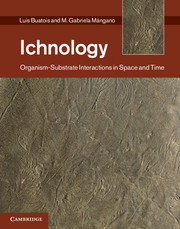Book contents
- Frontmatter
- Contents
- Acknowledgments
- Introduction
- Part I Conceptual tools and methods
- Part II Spatial trends
- 6 Trace fossils and paleoecology
- 7 Ichnology of shallow-marine clastic environments
- 8 Ichnology of marginal-marine environments
- 9 Ichnology of deep-marine clastic environments
- 10 Ichnology of continental environments
- 11 Ichnology of carbonate environments, rocky shorelines, and volcanic terrains
- Part III A matter of time
- References
- Index
9 - Ichnology of deep-marine clastic environments
from Part II - Spatial trends
Published online by Cambridge University Press: 25 October 2011
- Frontmatter
- Contents
- Acknowledgments
- Introduction
- Part I Conceptual tools and methods
- Part II Spatial trends
- 6 Trace fossils and paleoecology
- 7 Ichnology of shallow-marine clastic environments
- 8 Ichnology of marginal-marine environments
- 9 Ichnology of deep-marine clastic environments
- 10 Ichnology of continental environments
- 11 Ichnology of carbonate environments, rocky shorelines, and volcanic terrains
- Part III A matter of time
- References
- Index
Summary
Y cuando me hundo en el mar
de la fertilidad,
un silencio visual:es la fauna abisal
reflejando el color del sol
Gustavo CeratiLisa (1993)
Deep-marine trace fossils have long fascinated ichnologists with their amazing variety of shapes and sizes, arranged in regular and recurrent patterns (Fuchs, 1895). Graphoglyptids preserved at the base of sandy turbidites have represented a challenging puzzle. Trace fossils preserved in turbidites exposed mostly in European Mountain Chains (Fuchs, 1895; Azpeitia-Moros, 1933; Seilacher, 1962, 1977a; Książkiewicz, 1970, 1977; Crimes, 1977; Crimes et al., 1981), but also in South (Macsotay, 1967) and North (Chamberlain, 1971) America rapidly captured the attention of ichnologists. These structures were originally interpreted as post-turbidite (Seilacher, 1960), but after further research Seilacher (1962) was able to demonstrate that graphoglyptids were in fact pre-turbidite trace fossils formed as shallow-tier open burrow systems in the hemipelagic mud and preserved due to uniform stripping of the uppermost muddy layer by the incoming turbidity current and subsequent casting with sand. In another seminal paper, Seilacher (1977a) introduced a morphological classification of these structures, including continuous meanders (e.g. Helminthorhaphe and Cosmorhaphe), uniramous meanders (e.g. Belorhaphe, Helicolithus, and Urohelminthoida), biramous meanders (e.g. Desmograpton and Paleomeandron), radial structures (e.g. Glockerichnus and Lorenzinia), irregular networks (e.g. Megagrapton and Acanthorhaphe), and regular networks (e.g. Paleodictyon). The fact that these structures were originally described and interpreted from the fossil record, and only later recorded in the modern deep sea has been regarded as an example of reverse uniformitarianism, in which the past is the key to the present (Frey and Seilacher, 1980). Recent years have witnessed extraordinary progress in our understanding of the ichnotaxonomy of deep-marine trace fossils. Following a long tradition started by Polish ichnologist Marian Książkiewicz, a number of monographs have been published during the last 15 years or so (Uchman, 1995, 1998, 1999, 2001), allowing the establishment of a systematic framework to classify deep-marine trace fossils. Parallel to this, significant progress was attained in our knowledge of biogenic structures formed in the modern deep sea (e.g. Werner and Wetzel, 1982; Wetzel, 1981, 1984, 1991, 2002, 2008). Integration of modern observations and detailed systematic work are now resulting in more finely tuned ichnological and sedimentological models of turbidite systems (e.g. Wetzel and Uchman, 2001; Ponce et al., 2007; Olivero et al., 2010; Wetzel, 2010; Carmona and Ponce, 2011), including studies in based on cores (Knaust, 2009). In all probability, future work will emphasize the search for comparative ichnological signatures of various deep-sea processes, such as episodic turbidity currents, hyperpycnal flows, and bottom currents (e.g. Wetzel et al., 2008). In this chapter, we will review the ichnology of deep-marine environments, covering both slopes and base-of-slope turbidity systems. In order to do so, we will subdivide slopes in topographically simple and topographically complex, and turbidite systems into fine-grained and coarse-grained.
- Type
- Chapter
- Information
- IchnologyOrganism-Substrate Interactions in Space and Time, pp. 181 - 196Publisher: Cambridge University PressPrint publication year: 2011
- 1
- Cited by



